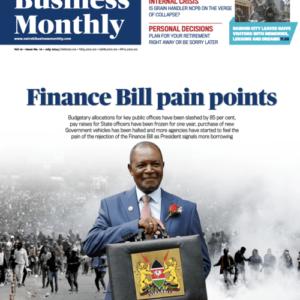BY ANTONY MUTUNGA
Kenya’s economy experienced one of its toughest years in 2017 when it faced, among others, a prolonged electioneering, adverse weather conditions and a slow down in credit access. Businesses suffered the most leading to job losses and in some extreme situations, their closure.
As a result, according to the Kenya National Bureau of Statistics (KNBS), the economy recorded a mere growth of 4.9% in that year, the slowest margin in the last five years, compared to the 5.9% in 2016. With the resulting stagnation in business growth and job loses, banks felt the pinch even more as a majority of businesses and individuals who rely on bank loans for expansion and personal growth defaulted.
Download Nairobi Business Monthly Latest Edition
Personal loan borrowers and traders, according to the Central Bank of Kenya (CBK) annual sector report, accounted for 45.89% of the total bad debts held by banks last year. Out of the Sh264.6 billion of the total bad debts, the group accounted for Sh121.4 billion in the year, laying bare the real state of the Kenyan economy and how fast it is deteriorating.
Since 2016, it has become difficult to access credit as a result of the interest rate cap. As for those who already had loans, they found it difficult to repay, resulting in reduced public expenditure and diminished bottom lines for businesses and thus the incapability to service loans.
The private sector, which is highly dependent on credit, was hit the most. With access to credit becoming a challenge, the sector activity weakened causing businesses to find other means of saving money such as through lay offs and retrenching. Additionally, the sector was also hit hard by the 2017 elections.
Despite being on a downward trend since 2016, according to the Kenya Private Sector Alliance (KEPSA), the sector lost an estimated $7 billion, which is an equivalent of about 10% of Kenya’s GDP from the effects of the heightened uncertainty the 2017 elections created.
Our economic well-being is highly dependent on the performance of the private sector and so this affected the country as a whole especially since cash-flow was heavily affected.
But the government must also share in the blame for the slowdown in the activities of the private sector. The Treasury delayed funds to the county governments, paralysing a number of activities in the devolved units. County governments were hence unable to pay contractors for a few months, which in turn made it difficult for these businesses to grow or pay back on their loans.
All the afore-mentioned resulted in the increase to new levels of the number of those who could not service their debts. According to data from the CBK, bad loans held by households increased by 16.2% from Sh37.2 billion in 2016 to Sh43.1 billion in 2017 while those held by trading firms increased by 29.6% from Sh62.2 billion in 2016 to Sh78.3 billion in 2017. Other sectors that saw increases in the distribution of bad loans include manufacturers, which saw an increase of 14.9% to Sh39.5 billion as the real estate sector accounted for a 14.2% increase in bad loans to Sh37.8 billion.
Banks were consequently, forced to sell the defaulters’ assets in order to try and recover their funds. That hasn’t been a walk in the park either as with the state of the economy, it is equally difficult to auction the assets due to lack of buyers.
There’s, however, always some light at the end of the tunnel. The economy is beginning to sprout some hope of a rebound. The private sector is beginning to pick up gradually even though this will be heavily dependant on how the new raft of unprecedented tax measures recently passed including the 8% levy on fuel will unfold. But the tourism sector is beginning to pick up and the heavy infrastructural investment by the government will for sure yield some results.
Government however, of necessity, needs to support and strengthen the credit sector. That the economy is dependent on the SMEs, which are in turn dependent on credit, should be the inspiration for the government to invent agreeable credit terms out of the stalemate. This should include reviewing of the interest rate cap to open up access to credit but in a manner that will not allow the banks to ran amok and ride roughshod over people as before the rate caps. In so doing, the total bad loans will reduce, people will invest again and create jobs and the economy will grow again.


